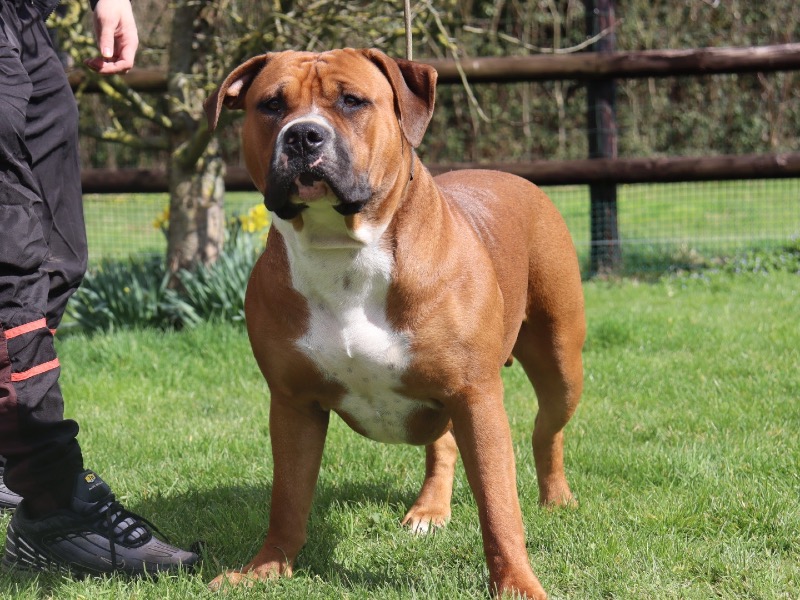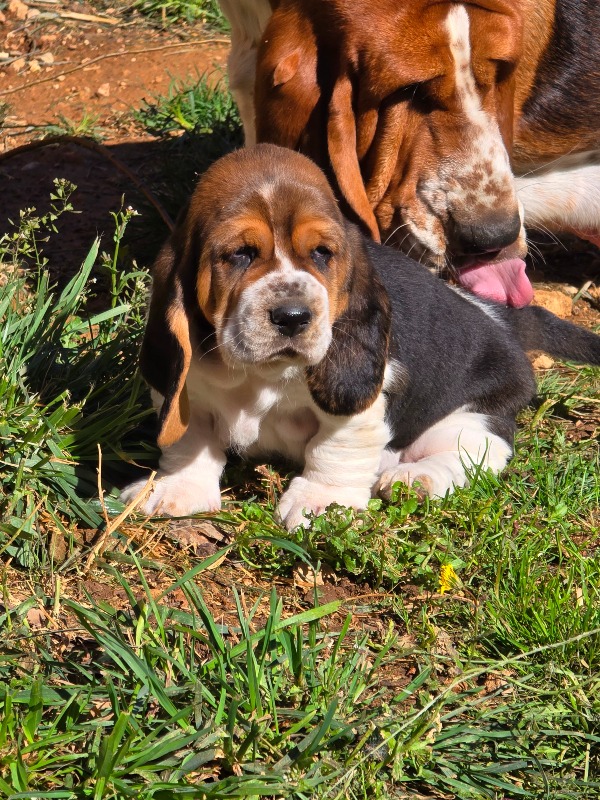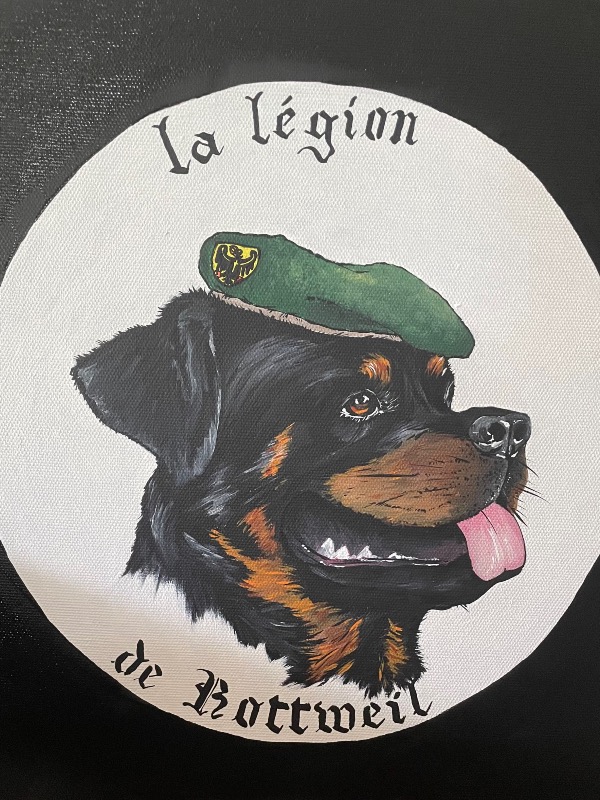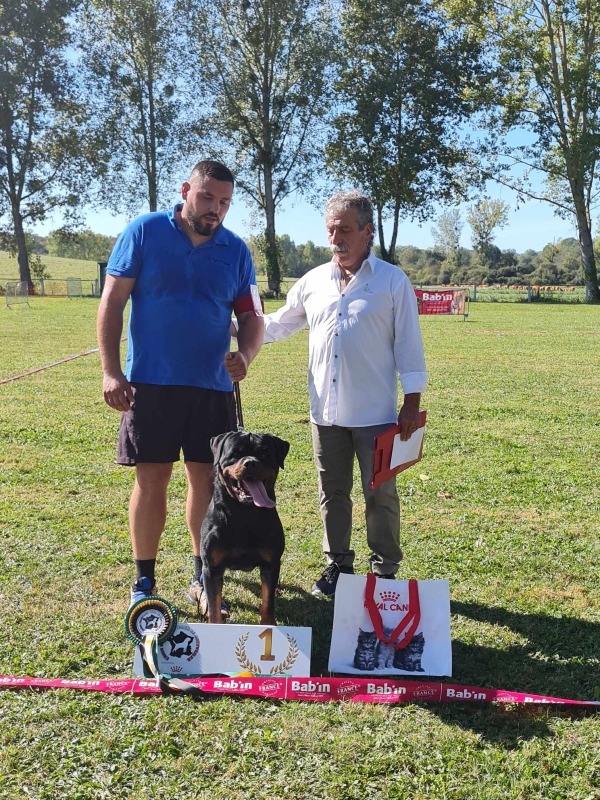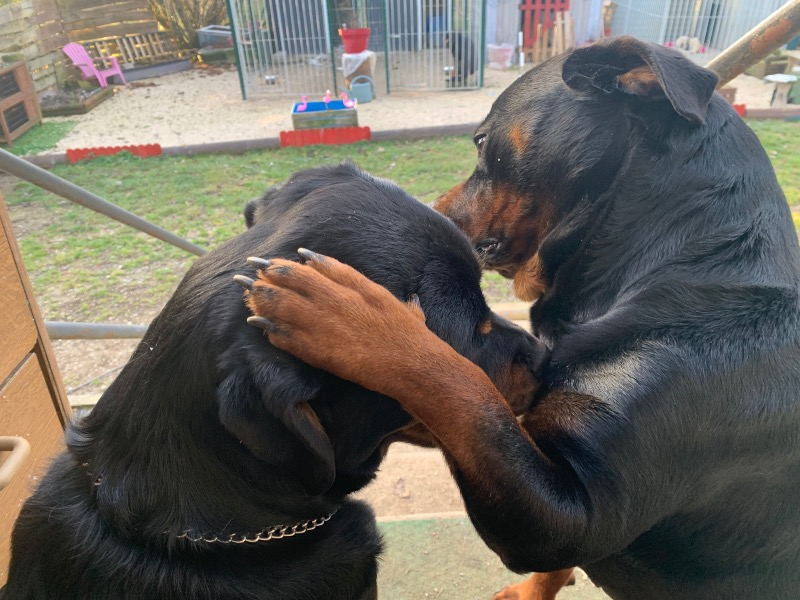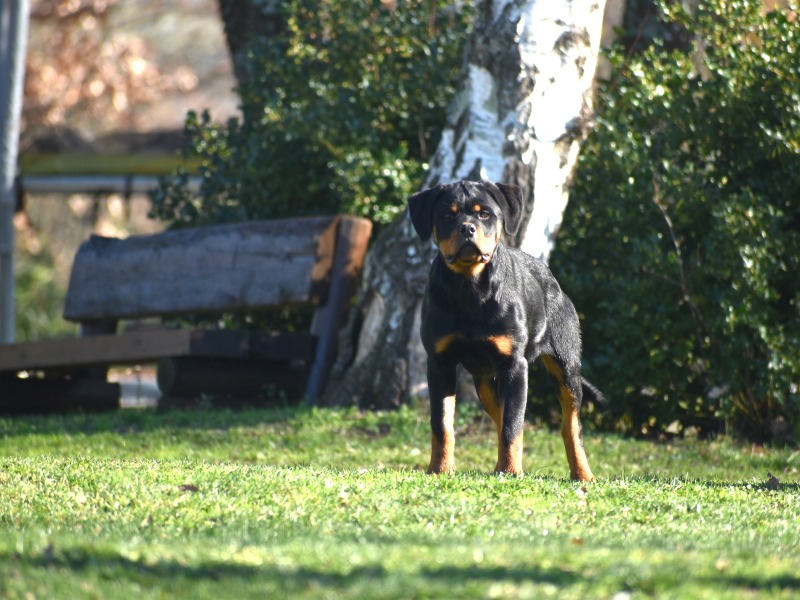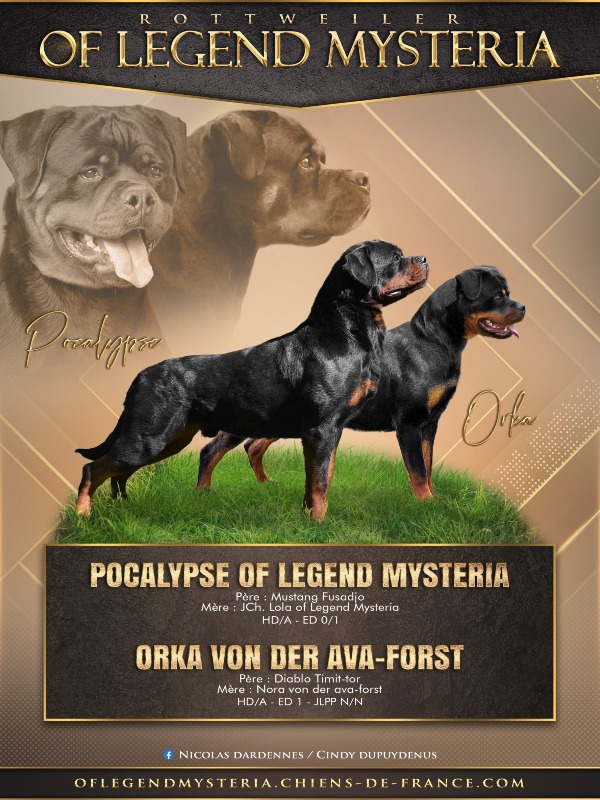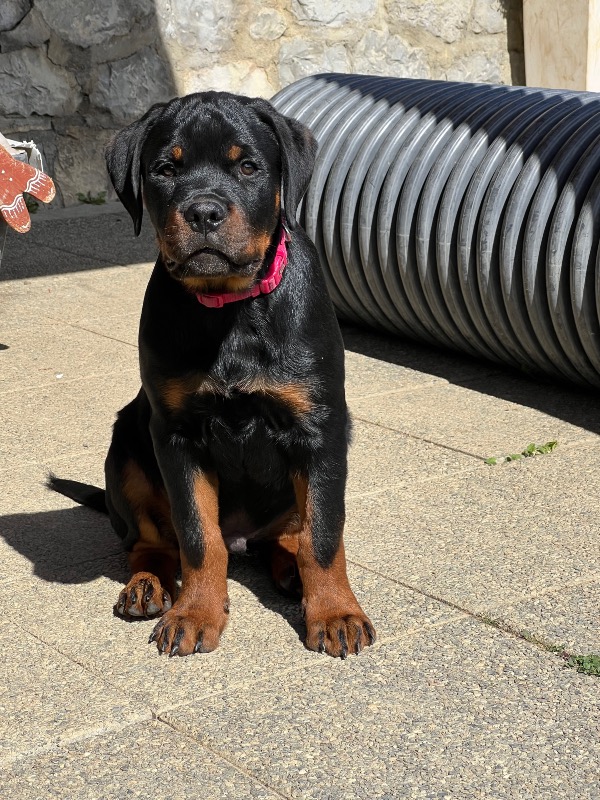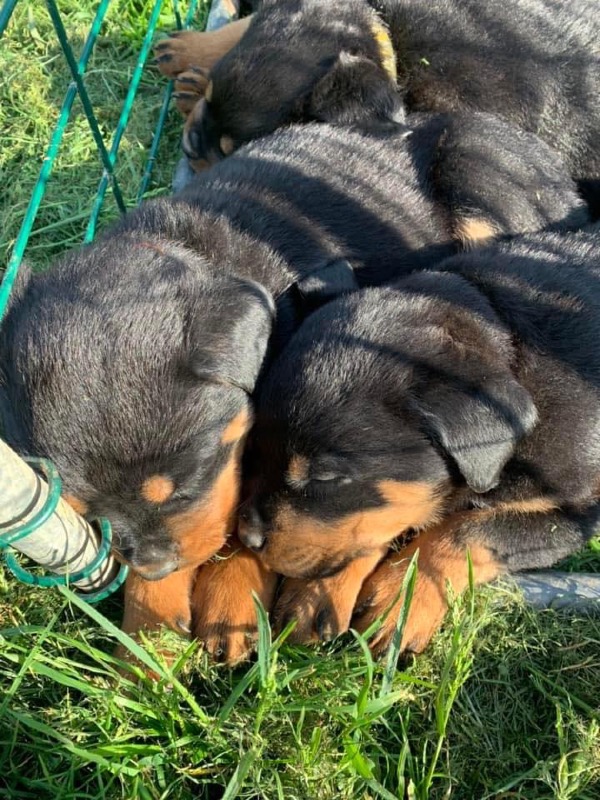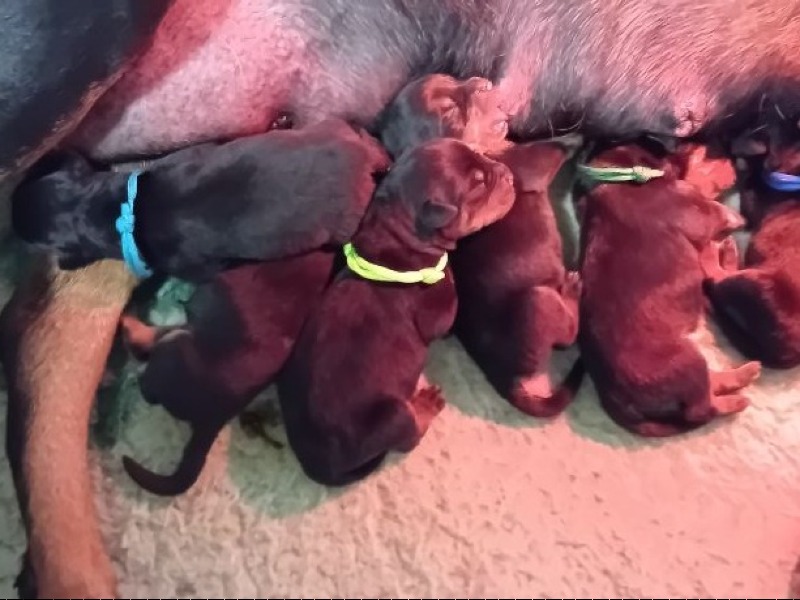Rottweiler
Welcome to our page dedicated to the breed of dog rottweiler!
Here, you will find all the useful information about rottweiler. This descriptive profile will allow you to discover the aspects of this breed. You can notably consult information about the average price, monthly and annual upkeep expenses, their health, name ideas, as well as their official recognition by competent authorities.
Explore this page to discover everything you need to know.
Overall description of the breed
The Rottweiler is one of the oldest breeds known to date, its ancestors were the faithful partners of the Roman legions during their battles, conditioned for combat and bloody battles. Like most molossoid dogs, its more distant origins are Asian, probably one of the many descendants of the Tibetan Matin. It was imported to Germany by the Roman legions in the wake of their victories, settling mainly in the Rottweil region, which later gave it part of its name.
Mainly used as a guard dog, especially by butchers, to protect their herds and businesses. However, as his selection progressed, breeders highlighted his versatility, thanks to his good physical qualities, his remarkable sense of smell and his legendary reliability. He has been used as a defence dog, search dog, herding dog and even as a sled dog. The Rottweiler is widely used in the administration, for military purposes or by the police, its sense of smell, its power and its endurance make it an excellent working dog since the beginning of the 20th century in Germany and Austria.
All the world's major organisations recognise the Rottweiler as a breed in its own right, including the Fédération Cynologique Internationale, which registered it definitively on 1 January 1955. The standard currently in force was published on 16 June 2018.
The Rottweiler is one of the larger dogs, its muscularity and imposing size are characteristics particularly appreciated by connoisseurs, stocky and vigorous, it is a true athlete with many physical qualities. Its body is slightly longer than it is tall, especially in females, so it fits into a rectangle. His thick bones and highly developed muscles make him a dog of considerable power, while maintaining a harmonious and supple morphology.
His chest is ample and deep, associated with a wide rib cage, slightly rounded ribs and a discreetly raised belly. The topline is straight, muscular and rather short, extending to a thick tail of moderate length, which may be shortened in some cases. The head of the Rottweiler is particularly massive, with a pronounced molossoid type, with a short and square muzzle, a clear stop, marked jaws, deep and rounded skull. The coat is short, smooth and hard-textured, with a thick undercoat, which provides excellent protection against the weather and cold. The only coat colour permitted by the breed standard is black and tan, with markings on the cheeks, muzzle, base of the legs, above the eyes, on the chest and under the tail, the tan markings must be clear and without brindle.
The Rottweiler is a very affectionate dog with his family, but he is much less affectionate with people he does not know or intruders who might try to venture onto his territory. With an overdeveloped protective instinct, he is an excellent guard dog, and is frequently used by security guards or the police, a profession where his intelligence and impressive physical abilities are highly appreciated. His reputation as a vicious dog is not justified at all, if his education is correctly applied, with fair and firm rules, you will discover an exceptional companion with the whole family, especially with the children whom he will protect with determination.
To control this large, energetic teddy bear, you will need to be patient and never let go of your authority. The Rottweiler is not suitable for novice owners, without a minimum of obedience experience you will find it difficult to control him completely, which can be dangerous over time. Not very barky, he is a silent guardian, who will let in the wrong people to trap them, always attentive to his environment, the slightest suspicious noise will put him on alert.
Close to his masters, he appreciates enormously the company of his social group, sharing playful or sporting activities, the Rottweiler needs to expend himself every day to feel good in his paws and to show himself calm inside. Its fusional temperament will not allow it to stay alone for too long, solitude will cause it to get into mischief if it is not used to your absences from a very young age. Generally speaking, he is rather dominant with his fellow dogs, an early socialization will be beneficial, so that he feels at ease in community.
Faithful and protective, the Rottweiler is an extraordinary everyday companion, his courage and love for his owners is known and recognized throughout the world, we are convinced that he will delight many families for decades to come.
Adult: The Rottweiler will weigh 110-121 lbs or more for males and 99-110 lbs for females, with a height at the withers of 24.5"-27" for males and 21.5"-25" for females.
Awareness of acquiring an animal
Each animal is a sensitive being, deserving love, attention and care.
When you choose to adopt an animal, you take on the responsibility of ensuring its health and well-being throughout its life.
To learn more about animal welfare, we invite you to consult our FAQ by clicking the button below:
Origins
The Rottweiler originates from Germany, where it was developed in the Rottweil region. This breed descends from the ancient herding dogs used by the Romans during their conquests. These dogs were used to guard and drive livestock, as well as to protect military camps. By mixing with local dogs, they gave birth to the Rottweiler. The butchers of Rottweil perfected the breed to make it a robust and reliable dog, capable of driving cattle to market and protecting the money from sales. The Rottweiler has therefore inherited a strong aptitude for work, both as a herding dog and as a loyal guardian.
History
The history of the Rottweiler is deeply rooted in ancient Europe. The ancestors of this breed were herding dogs used by Roman legions to guard and drive livestock during their travels across Europe. Over time, these dogs were crossed with local dogs in Germany, giving birth to the Rottweiler we know today. In the Middle Ages, the city of Rottweil became an important center for livestock trade, and local butchers bred these dogs for their exceptional abilities to work with livestock and protect property. In the 19th century, with the advent of railways, the role of the Rottweiler evolved into that of a guard and police dog, a function it continues to excel in today.
Standard
The Rottweiler breed standard, as defined by the Fédération Cynologique Internationale (FCI) and the American Kennel Club (AKC), describes a medium to large-sized, sturdy and powerful dog. The head is of medium size, with a wide and slightly domed skull. The muzzle is strong, with powerful jaws and a black nose. The eyes are medium-sized, almond-shaped, and dark brown in color, showing an intelligent and attentive expression. The ears are medium-sized, triangular, and drooping. The body is compact and muscular, with a broad and deep chest. The tail is usually left natural in Europe, while it is often docked in the United States. The coat is short, dense, and black with distinct tan markings.
Physical characteristics
The Rottweiler is a medium to large-sized dog, well-proportioned and extremely muscular. Males typically measure between 61 and 68 cm at the withers and weigh between 45 and 60 kg, while females measure between 56 and 63 cm and weigh between 35 and 48 kg. Their coat is short, dense, and smooth, with a waterproof undercoat. The color of the coat is always black with well-defined tan markings on the cheeks, muzzle, legs, chest, and base of the tail. The skull is wide and slightly dome-shaped, with strong jaws and a powerful muzzle. The eyes are medium-sized, oval in shape, and dark brown in color, showing an alert and attentive expression.
Character
The Rottweiler is known for its loyal, protective, and courageous character. It is an extremely devoted dog to its family, often described as affectionate and loving. Intelligent and versatile, it excels in various tasks, including guarding, protection, and dog sports. Although it may be reserved with strangers, it is generally confident and calm, rarely showing signs of aggression without provocation. The Rottweiler is also very playful and energetic, enjoying physical activities and interactive games. Its protective nature makes it an excellent guard dog, but it requires proper socialization and training from a young age to correctly channel its protective instincts and ensure balanced behavior.
Life expectancy
The Rottweiler has an average life expectancy of 8 to 10 years. This longevity can vary depending on several factors, including genetics, diet, exercise, and veterinary care. Owners should be vigilant about common health problems in this breed, such as hip and elbow dysplasia, heart disease, and certain cancers. Regular veterinary check-ups, balanced nutrition, and appropriate physical activity can help prevent and manage these conditions, contributing to a longer and healthier life for the dog. Well-cared-for Rottweilers, living a healthy lifestyle with plenty of love and attention, can often live beyond the average.
Exercise and activity needs
The Rottweiler is an active and energetic breed that requires a significant amount of exercise to stay healthy and happy. It is recommended to provide them with at least one to two hours of daily exercise, which can include long walks, runs, fetch games, and mentally stimulating activities. Canine sports such as agility, flyball, and obedience are particularly beneficial for this breed as they help to channel their energy and intelligence. Rottweilers also enjoy mental challenges such as dog puzzles and training sessions. Regular exercise helps to prevent boredom and destructive behaviors, ensuring a balanced and content dog.
Recommended diet
The Rottweiler's diet must be balanced and adapted to its high energy needs. High quality, protein-rich and essential nutrient-rich food is recommended. Premium kibble specially formulated for large active breeds is ideal. An adult Rottweiler consumes an average of 400 to 700 grams of dry food per day, divided into two meals. The monthly cost of food varies between 50 and 100 euros, depending on the quality of the products chosen. It is crucial to monitor its weight and avoid overeating, as obesity can lead to various health problems. Dietary supplements may be considered to support joint and heart health, including omega-3 fatty acids and glucosamine.
Training and obedience
The Rottweiler is an intelligent and receptive breed, but its education and training require a firm and consistent approach. Starting training at a young age is essential to establish good habits and proper socialization. Positive reinforcement methods, such as treats and praise, are particularly effective with this breed. Consistency and patience are the keys to success. Rottweilers respond well to basic commands like "sit", "come", "heel", and "stay". Early socialization with other dogs and various environments helps prevent undesirable behaviors. Obedience classes and activities like agility can also be beneficial for stimulating their active mind and strengthening the bond with their owner.
Behavior with children
The Rottweiler is often considered an excellent companion for children due to its protective, loyal, and patient nature. With proper socialization and training, it can be gentle and tolerant with younger family members. It is important to supervise interactions between young children and the dog to prevent unintentional accidents. Teaching children to respect the dog and interact with it appropriately is essential for harmonious cohabitation. The Rottweiler, with its stable and rarely aggressive temperament, can become a loving and protective companion for children, providing a reassuring and faithful presence within the family.
Compatibility with Other Animals
The Rottweiler can coexist with other pets, but it often requires early socialization and gradual introduction. Well-socialized Rottweilers from a young age generally get along well with other dogs and even cats. Monitoring initial interactions is important to ensure they go smoothly and encouraging positive experiences. Rottweilers may sometimes show dominance instincts, but with proper training and ongoing socialization, they can live in harmony with other animals. The key is to promote positive interactions and reinforce good behaviors to ensure peaceful coexistence.
Grooming needs
The Rottweiler has a short, dense, and smooth coat that requires relatively little grooming. Weekly brushing is sufficient to remove dead hair and keep the coat shiny and healthy. During shedding seasons in spring and autumn, brushing should be intensified to manage excess hair. Baths are only necessary occasionally, or when the dog is particularly dirty, using a gentle dog shampoo. Ears should be checked and cleaned regularly to prevent infections, and teeth should be brushed frequently to avoid dental problems. Nails should be trimmed regularly to prevent injuries. Regular grooming helps to quickly detect skin problems or other anomalies, thus contributing to the overall health and well-being of the Rottweiler.
Health
The Rottweiler is generally a robust breed, but is prone to certain hereditary health conditions. Common health issues include hip and elbow dysplasia, heart diseases, and some cancers. It is crucial to choose a reputable breeder who tests their dogs for these conditions to minimize risks. A balanced diet, regular exercise, and periodic veterinary visits are essential to maintain their health. Rottweilers can also be prone to eye problems and skin allergies. Regular veterinary care helps detect and treat these conditions quickly, contributing to a long and healthy life for the dog. With proper care, the Rottweiler can live an active and healthy life, with an average lifespan of 8 to 10 years.
Average price
The price of a Rottweiler can vary considerably depending on several factors, such as lineage, pedigree, breeder reputation, and geographic location. In general, the average price for a Rottweiler puppy is between 1,000 and 2,000 euros. Specimens from champion bloodlines or with exceptional characteristics can cost much more, sometimes up to 3,000 euros or more. It is essential to choose a reputable breeder who adheres to health and animal welfare standards. Although this may mean paying a higher price, it often ensures a healthy and well-socialized puppy. Prospective owners should also budget for additional expenses for veterinary care, food, accessories, and training.
Expenses
Monthly expenses for a Rottweiler can vary depending on several factors, including food, veterinary care, grooming, and accessories. On average, owners can expect to spend between 70 and 150 euros per month. Quality food, tailored to the specific needs of the breed, costs around 50 to 80 euros per month. Regular veterinary care, including vaccinations and parasite treatments, can add 10 to 30 euros per month. Grooming, although minimal, can cost 10 to 20 euros per month if done by a professional. Toys, treats, and other accessories can add an additional 10 to 20 euros. These costs can vary depending on the specific needs of each dog and the owner's choices.
Name ideas
Choosing a name for your Rottweiler can be a fun and exciting task. Here are some name suggestions that may suit the personality and imposing appearance of this breed: Max, Luna, Rocky, Bella, Zeus, Daisy, Charlie, Maya, Rex, Ruby, Thor, Nala, Bruno, Athena, Oscar, Zara, Milo, Sadie, Ginger, Toby. When choosing a name, it is important to consider its pronunciation and make sure it does not sound too much like basic commands to avoid confusion during training. Take the time to observe your dog and choose a name that reflects its unique personality and strong, majestic appearance.
Legislation and regulation
In France, the Rottweiler is classified in category 2 according to the legislation on so-called dangerous dogs. Owners must comply with specific regulations, such as declaration to the town hall, sterilization of category 1 dogs, holding a certificate of aptitude and obtaining a detention permit. Rottweilers must be identified by microchip or tattoo and be up to date on their vaccinations. They must also be kept on a leash and muzzled in public places. Owners must take out civil liability insurance to cover any damages caused by their dog. When traveling abroad, it is crucial to check the specific requirements of the destination country regarding health certificates and vaccinations.
Official recognition
The Rottweiler is recognized by several cynological organizations around the world. In France, it is recognized by the Société Centrale Canine (SCC). Internationally, it is recognized by the Fédération Cynologique Internationale (FCI), the American Kennel Club (AKC) in the United States, the Kennel Club (KC) in the United Kingdom, and the Canadian Kennel Club (CKC) in Canada. These organizations define the breed standards and organize dog shows where Rottweilers can be presented and evaluated. Recognition by these organizations also ensures that breeders adhere to health, temperament, and conformation standards, contributing to the preservation and improvement of the breed. Pedigrees issued by these organizations guarantee the purity and quality of the bloodlines.
Pedigrees
Rottweilers can obtain pedigrees recognized by various breed clubs around the world, ensuring their pure lineage and compliance with breed standards. In France, the Société Centrale Canine (SCC) issues pedigrees. In the United States, the American Kennel Club (AKC) offers pedigrees for Rottweilers. In the United Kingdom, the Kennel Club (KC) also issues pedigrees for this breed. Other organizations such as the Fédération Cynologique Internationale (FCI) and the Canadian Kennel Club (CKC) recognize and issue pedigrees for Rottweilers. These organizations verify the dogs' origins and certify that they meet the breed criteria, ensuring the quality and purity of the bloodlines.
Destination and usage
The Rottweiler is a versatile breed primarily bred as a working and companion dog. Thanks to its intelligence, strength and courage, it excels in various functions, including as a guard dog, protection dog, police dog and search and rescue dog. The Rottweiler is also an excellent family companion, appreciated for its loyalty and affection. Due to its balanced temperament and desire to please, it often participates in dog sports competitions such as agility, obedience and schutzhund. Some Rottweilers are also used as therapy dogs due to their calm and tolerant nature, providing comfort and joy to people in hospitals and retirement homes.
Prohibitions
In France, the Rottweiler is classified as a category 2 dangerous dog, which implies some restrictions. Owners must declare their dog at the town hall, obtain a certificate of aptitude and a detention permit, and take out civil liability insurance. Rottweilers must be identified by microchip or tattoo, vaccinated, and kept on a leash and muzzled in public places. In some countries, regulations may be even stricter, up to the prohibition of ownership. It is essential to check local and national laws regarding the ownership of Rottweilers, especially when traveling or moving, to avoid any offense and ensure a harmonious and legal cohabitation with your dog.
Breeders of Rottweiler
Want to see more breeders of Rottweiler?
Check out the page of our directory listing all breeders of RottweilerClassified Ads of Rottweiler
Breed clubs of rottweiler
No of rottweiler breed clubs are currently registered on Preeders.
If you would like to highlight your breed club, sign up for free now and be the first to appear on this page.

